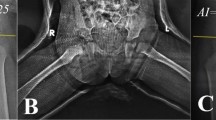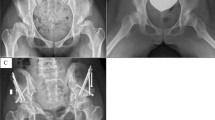Abstract
Introduction
Bernese-type triple pelvic osteotomy (BTPO) combines periacetabular and triple innominate osteotomy techniques. However, studies that evaluate the clinical and radiographic outcomes of BTPO are scarce. The aim of this study is to report on the clinical and radiographic outcomes of ambulatory children with developmental dysplasia of the hip (DDH) or Legg-Calvé-Perthes disease (LCPD) managed with BTPO that were older than five years of age at the time of surgery.
Materials and methods
We retrospectively reviewed the records of 27 consecutive patients with DDH or LCPD (mean age 7.6 ± 1.8; 28 hips) who were treated with the reported technique. All patients had regular clinical and radiographic follow-up. Post-operatively, changes in the acetabular index (AI) and centre-edge angle of Wiberg (CEA) were measured in all patients. The presence/absence of avascular necrosis of the femoral epiphysis was also noted in patients with DDH. Final radiographic results were evaluated with the Severin and Stulberg classifications. The Harris hip score was used in the functional evaluation of all patients.
Results
In patients with DDH, the mean age at the time of surgery was 7.5 ± 1.8 years and the mean follow-up time was 22.2 ± 10.7 months. Prior to surgery, the mean AI was 37.9° ± 7.6°. At their final follow-up visit, the mean AI and CEA were 10.8° ± 5.4° and 40.9° ± 8.6°, respectively. Moreover, 66.7% of hips (14/21) were graded as Severin type I, and 33.3% (7/21) were graded as type II. The overall AVN rate was 14.3% (3/21). The mean Harris score was 92.1 ± 7.7. In patients with LCPD, the mean age at the time of surgery was 7.9 ± 1.8 years, and the mean follow-up time was 18.4 ± 6.1 months. Prior to surgery, 85.7% of hips were graded as Herring C, and 14.3% were graded as grade B. Prior to surgery, the mean AI and CEA were 19.4° ± 5.3° and 19.1° ± 12.6°, respectively. At the final follow-up visit, the mean AI and CEA were 5.8° ± 3.4° and 50.3° ± 12.0°, respectively, and 57.1% of hips were graded as Stulberg II. The mean Harris score was 94 ± 5.4. Ischial osteotomy non-unions were recorded in three patients (10.7%).
Conclusions
BTPO through a modified anterior Smith-Peterson approach is an alternative treatment for DDH and LCPD in older children who are skeletally immature. It not only provides for a large acetabular correction but also achieves good biomechanical stability.





Similar content being viewed by others
References
Pailhe R, Cavaignac E, Murgier J, Cahuzac JP, de Gauzy JS, Accadbled F (2016) Triple osteotomy of the pelvis for Legg-Calve-Perthes disease: a mean fifteen year follow-up. Int Orthop 40(1):115–122. https://doi.org/10.1007/s00264-015-2687-9
Chen Q, Deng Y, Fang B (2015) Outcome of one-stage surgical treatment of developmental dysplasia of the hip in children from 1.5 to 6 years old. A retrospective study. Acta Orthop Belg 81(3):375–383
Wang CW, Wang TM, Wu KW, Huang SC, Kuo KN (2016) The comparative, long-term effect of the salter osteotomy and Pemberton acetabuloplasty on pelvic height, scoliosis and functional outcome. Bone Joint J 98-b(8):1145–1150. https://doi.org/10.1302/0301-620x.98b8.37215
Rebello G, Zilkens C, Dudda M, Matheney T, Kim YJ (2009) Triple pelvic osteotomy in complex hip dysplasia seen in neuromuscular and teratologic conditions. J Pediatr Orthop 29(6):527–534. https://doi.org/10.1097/BPO.0b013e3181b2b3be
LeCoeur P (1965) Correction of the abnormal acetabular orientation with isthmic osteotomy of the ilium [in French]. Rev Chir Orthop 51:211–212
Gillingham BL, Sanchez AA, Wenger DR (1999) Pelvic osteotomies for the treatment of hip dysplasia in children and young adults. J Am Acad Orthop Surg 7(5):325–337
Steel HH (1977) Triple osteotomy of the innominate bone. A procedure to accomplish coverage of the dislocated or subluxated femoral head in the older patient. Clin Orthop Relat Res 122:116–127
Tonnis D, Behrens K, Tscharani F (1981) A modified technique of the triple pelvic osteotomy: early results. J Pediatr Orthop 1(3):241–249
Sutherland DH, Greenfield R (1977) Double innominate osteotomy. J Bone Joint Surg Am 59(8):1082–1091
Ganz R, Klaue K, Vinh TS, Mast JW (1988) A new periacetabular osteotomy for the treatment of hip dysplasias. Technique and preliminary results. Clin Orthop Relat Res 232:26–36
Sankar WN (2014) Modified Bernese triple innominate osteotomy. In: Nho S, Leunig M, Kelly B, Bedi A, Larson C (eds) Hip arthroscopy and hip joint preservation surgery. Springer New York, New York, NY, pp 1–15. https://doi.org/10.1007/978-1-4614-7321-3_32-1
Sankar WN (2015) Surgical technique: modified Bernese triple innominate osteotomy. In: Nho SJ, Leunig M, Larson CM, Bedi A, Kelly BT (eds) Hip arthroscopy and hip joint preservation surgery. Springer New York, New York, NY, pp 439–448. https://doi.org/10.1007/978-1-4614-6965-0_32
Harris WH (1969) Traumatic arthritis of the hip after dislocation and acetabular fractures: treatment by mold arthroplasty. An end-result study using a new method of result evaluation. J Bone Joint Surg Am 51(4):737–755
Kalamchi A, MacEwen GD (1980) Avascular necrosis following treatment of congenital dislocation of the hip. J Bone Joint Surg Am 62(6):876–888
Severin E (1941) Contribution to the knowledge of congenital dislocation of the hip joint. Acta Chir Scand 84(Suppl 63):1–142
Gage JR, Winter RB (1972) Avascular necrosis of the capital femoral epiphysis as a complication of closed reduction of congenital dislocation of the hip. A critical review of twenty years’ experience at Gillette Children’s Hospital. J Bone Joint Surg Am 54(2):373–388
Herring JA, Neustadt JB, Williams JJ, Early JS, Browne RH (1992) The lateral pillar classification of Legg-Calve-Perthes disease. J Pediatr Orthop 12(2):143–150
Stulberg SD, Cooperman DR, Wallensten R (1981) The natural history of Legg-Calve-Perthes disease. J Bone Joint Surg Am 63(7):1095–1108
Li T, Liu Z, Ma Y, Wang Y (2013) Bernese triple osteotomy for developmental dysplasia of the hip and its residual deformity in elder children (Bernese骨盆三联截骨术治疗大龄DDH与DDH残留畸形). Chin J Pediatr Surg 34(4):286–289
Thompson GH (2011) Salter osteotomy in Legg-Calve-Perthes disease. J Pediatr Orthop 31(2 Suppl):S192–S197. https://doi.org/10.1097/BPO.0b013e318223b59d
Wall EJ (1999) Legg-Calve-Perthes’ disease. Curr Opin Pediatr 11(1):76–79
Vukasinovic Z, Vucetic C, Spasovski D, Zivkovic Z (2008) Legg-Calve-Perthes disease—diagnostics and contemporary treatment. Srp Arh Celok Lek 136(7–8):430–434
Camurcu IY, Yildirim T, Buyuk AF, Gursu SS, Bursali A, Sahin V (2015) Tonnis triple pelvic osteotomy for Legg-Calve-Perthes disease. Int Orthop 39(3):485–490. https://doi.org/10.1007/s00264-014-2585-6
Wenger DR, Pring ME, Hosalkar HS, Caltoum CB, Lalonde FD, Bastrom TP (2010) Advanced containment methods for Legg-Calve-Perthes disease: results of triple pelvic osteotomy. J Pediatr Orthop 30(8):749–757. https://doi.org/10.1097/BPO.0b013e3181f5a0de
Vukasinovic Z, Spasovski D, Vucetic C, Cobeljic G, Zivkovic Z, Matanovic D (2009) Triple pelvic osteotomy in the treatment of Legg-Calve-Perthes disease. Int Orthop 33(5):1377–1383. https://doi.org/10.1007/s00264-009-0745-x
Babis GC, Trousdale RT, Jenkyn TR, Kaufman K (2002) Comparison of two methods of screw fixation in periacetabular osteotomy. Clin Orthop Relat Res 403:221–227
Yao F, He Y, Qian H, Zhou D, Li Q (2015) Comparison of biomechanical characteristics and pelvic ring stability using different fixation methods to treat pubic symphysis diastasis: a finite element study. Medicine (Baltimore) 94(49):e2207. https://doi.org/10.1097/md.0000000000002207
Kotzias Neto A, Ferraz A, Bayer Foresti F, Barreiros Hoffmann R (2014) Bilateral developmental dysplasia of the hip treated with open reduction and salter osteotomy: analysis on the radiographic results. Rev Bras Ortop 49(4):350–358. https://doi.org/10.1016/j.rboe.2014.03.023
Mootha AK, Saini R, Dhillon M, Aggarwal S, Wardak E, Kumar V (2010) Do we need femoral derotation osteotomy in DDH of early walking age group? A clinico-radiological correlation study. Arch Orthop Trauma Surg 130(7):853–858. https://doi.org/10.1007/s00402-009-1020-8
Ning B, Yuan Y, Yao J, Zhang S, Sun J (2014) Analyses of outcomes of one-stage operation for treatment of late-diagnosed developmental dislocation of the hip: 864 hips followed for 3.2 to 8.9 years. BMC Musculoskelet Disord 15:401. https://doi.org/10.1186/1471-2474-15-401
Forlin E, Munhoz da Cunha LA, Figueiredo DC (2006) Treatment of developmental dysplasia of the hip after walking age with open reduction, femoral shortening, and acetabular osteotomy. Orthop Clin North Am 37(2):149–160, vi. https://doi.org/10.1016/j.ocl.2005.11.005
Galpin RD, Roach JW, Wenger DR, Herring JA, Birch JG (1989) One-stage treatment of congenital dislocation of the hip in older children, including femoral shortening. J Bone Joint Surg Am 71(5):734–741
Ryan MG, Johnson LO, Quanbeck DS, Minkowitz B (1998) One-stage treatment of congenital dislocation of the hip in children three to ten years old. Functional and radiographic results. J Bone Joint Surg Am 80(3):336–344
Schoenecker PL, Strecker WB (1984) Congenital dislocation of the hip in children. Comparison of the effects of femoral shortening and of skeletal traction in treatment. J Bone Joint Surg Am 66(1):21–27
Sankar WN, Tang EY, Moseley CF (2009) Predictors of the need for femoral shortening osteotomy during open treatment of developmental dislocation of the hip. J Pediatr Orthop 29(8):868–871. https://doi.org/10.1097/BPO.0b013e3181c29cb2
Wenger DR, Lee CS, Kolman B (1995) Derotational femoral shortening for developmental dislocation of the hip: special indications and results in the child younger than 2 years. J Pediatr Orthop 15(6):768–779
Mimura T, Mori K, Kawasaki T, Imai S, Matsusue Y (2014) Triple pelvic osteotomy: report of our mid-term results and review of literature. World J Orthop 5(1):14–22. https://doi.org/10.5312/wjo.v5.i1.14
Hailer NP, Soykaner L, Ackermann H, Rittmeister M (2005) Triple osteotomy of the pelvis for acetabular dysplasia: age at operation and the incidence of nonunions and other complications influence outcome. J Bone Joint Surg Br 87(12):1622–1626. https://doi.org/10.1302/0301-620x.87b12.15482
Conroy E, Sheehan E, OC P, Connolly P, McCormack D (2010) Triple pelvic osteotomy in Legg-Calve-Perthes disease using a single anterolateral incision: a 4-year review. J Pediatr Orthop B 19(4):323–326. https://doi.org/10.1097/BPB.0b013e32833822a4
Lipton GE, Bowen JR (2005) A new modified technique of triple osteotomy of the innominate bone for acetabular dysplasia. Clin Orthop Relat Res 434:78–85
Dungl P, Rejholec M, Chomiak J, Grill F (2007) The role of triple pelvic osteotomy in therapy of residual hip dysplasia and sequel of AVN: long-term experience. Hip Int 17(Suppl 5):S51–S64
van Hellemondt GG, Sonneveld H, Schreuder MH, Kooijman MA, de Kleuver M (2005) Triple osteotomy of the pelvis for acetabular dysplasia: results at a mean follow-up of 15 years. J Bone Joint Surg Br 87(7):911–915. https://doi.org/10.1302/0301-620x.87b7.15307
Vukasinovic Z, Pelillo F, Spasovski D, Seslija I, Zivkovic Z, Matanovic D (2009) Triple pelvic osteotomy for the treatment of residual hip dysplasia. Analysis of complications. Hip Int 19(4):315–322
Tschauner C, Sylkin A, Hofmann S, Graf R (2003) Painful nonunion after triple pelvic osteotomy. Report of five cases. J Bone Joint Surg Br 85(7):953–955
Peters CL, Fukushima BW, Park TK, Coleman SS, Dunn HK (2001) Triple innominate osteotomy in young adults for the treatment of acetabular dysplasia: a 9-year follow-up study. Orthopedics 24(6):565–569
Author information
Authors and Affiliations
Corresponding author
Ethics declarations
Conflict of interest
The authors declare that they have no conflict of interest.
Ethical approval
All procedures performed in studies involving human participants were in accordance with the ethical standards of the institutional and/or national research committee and with the 1964 Helsinki Declaration and its later amendments or comparable ethical standards.
Informed consent
No patients were involved. This is a retrospective study of patient’s data, and an IRB approval was obtained.
Rights and permissions
About this article
Cite this article
Li, Y., Xu, H., Slongo, T. et al. Bernese-type triple pelvic osteotomy through a single incision in children over five years: a retrospective study of twenty eight cases. International Orthopaedics (SICOT) 42, 2961–2968 (2018). https://doi.org/10.1007/s00264-018-3946-3
Received:
Accepted:
Published:
Issue Date:
DOI: https://doi.org/10.1007/s00264-018-3946-3




